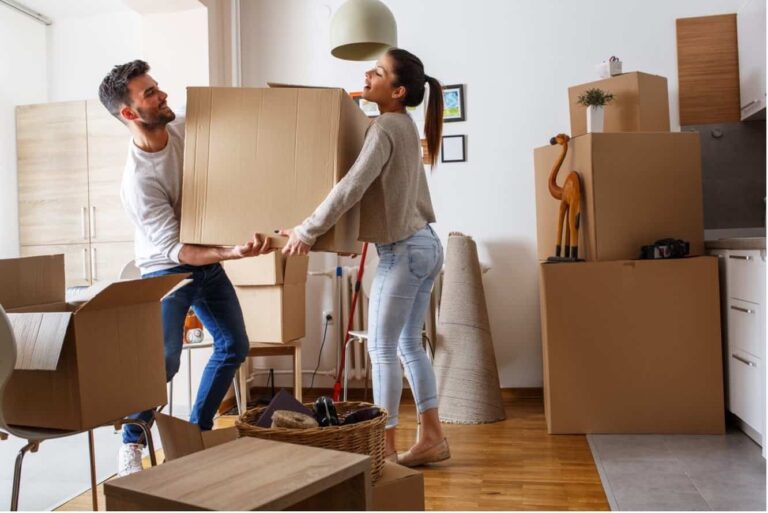So you’re about to move, huh? I know exactly how that feels – excited about new place but maybe a little overwhelmed by all the stuff you need to pack up.
Don’t worry, I’ve been there more times than I can count! Moving doesn’t have to be that stressful tornado everyone makes it out to be.
I’ve picked up tons of packing tricks over the years – some from my own moves, others from friends who seem to move every other year. The right packing strategy can be a total game-changer. Trust me, there’s nothing worse than arriving at your new place and having no idea where anything is!
Let me walk you through some seriously helpful packing tips that’ll make your move so much smoother. These aren’t complicated techniques – just simple, practical ideas that actually work in real life. Ready to make your move a whole lot easier? Let’s jump right in!
9 Detailed Packaging Guide When You’re Moving
Before we dive into all the details, let’s get a quick snapshot of what we’ll cover. Think of this as your moving roadmap! We’ll talk about making a solid plan, getting rid of stuff you don’t need, using the right supplies, labeling like a pro, and more practical tips that’ll save you tons of headaches.
I promise these aren’t just fancy ideas that look good on paper but fall apart in real life. These are tried-and-true methods that regular people like you and me can actually use. Some might even surprise you with how simple yet effective they are!
1. Start with a Packing Plan
You know what makes packing ten times harder? Just diving in without a plan! I learned this the hard way during my first big move when I ended up with random stuff packed together and no system whatsoever.
A good packing plan doesn’t need to be super detailed or fancy. Just grab a notebook and write down which rooms you’ll tackle first. I usually start with rooms I use less often, like the guest room or formal dining area.
Give yourself a timeline too. Maybe pack 3-4 boxes a day instead of trying to do everything in one exhausting weekend. Your back will thank you!
Make a list of what needs special attention – like artwork, electronics, or family heirlooms. This helps you remember to give these items extra care when packing day comes around.
I always keep my packing plan on the fridge where I can see it every day. Checking things off as I go gives me this little boost of accomplishment that keeps me motivated through the whole process.
2. Declutter Before You Pack
This is probably my favorite part of moving, believe it or not! Moving gives you the perfect excuse to finally deal with all that stuff that’s been piling up over the years.
Why pack things you don’t even use or love anymore? That’s just wasting boxes, tape, and most importantly – your energy! Before you pack a single item, go through everything and create three piles: keep, donate, and toss.
Be honest with yourself about what you actually use. That juicer you used twice five years ago? The pants that might fit again someday? The books you’ll probably never read again? Let them go to someone who’ll actually use them!
I once helped my friend pack her kitchen, and we found seven spatulas! Seven! She kept her favorite two and donated the rest. Her new kitchen was so much easier to organize with less clutter.
When I did my big move last year, I got rid of almost a third of my stuff. Not only did it make the move cheaper and easier, but my new place feels so much more peaceful without all that extra junk.
3. Use the Right Packing Materials
Having the right supplies makes such a huge difference in how smoothly your packing goes. You don’t need fancy expensive stuff, but a few basics will save you tons of stress.
Strong boxes in different sizes are a must. Those flimsy ones from the grocery store might be free, but they could collapse under the weight of your books! I usually mix free boxes with a few sturdy ones I buy specifically for heavier items.
Don’t forget packing tape – and lots of it! Nothing’s worse than running out of tape halfway through packing a box. I always buy more than I think I’ll need.
Bubble wrap is great for fragile items, but you can also use towels, blankets, and clothing as padding. It saves money and packs two things at once! I wrapped all my picture frames in beach towels during my last move.
My friend who used local movers in Memphis told me they recommended having markers, labels, and packing paper on hand too. She said being prepared with all these supplies from day one made the whole process so much smoother.
For furniture, plastic wrap or old sheets can protect surfaces from scratches. And those little baggies for screws and bolts? Absolute lifesavers when you’re putting furniture back together!
4. Label Everything Clearly
I cannot stress this enough – label, label, label! Nothing’s more frustrating than trying to find your coffee maker on that first morning in your new place and having to open 15 boxes marked “kitchen.”
Go beyond just writing the room name. Add a quick list of what’s inside each box. Something like “Kitchen – Pots, Pans, Cutting Boards” tells you exactly what you’re looking at.
I like using colored markers to color-code boxes by room. Blue for bathroom, red for kitchen, green for living room – it makes unloading so much faster when everyone can see at a glance where each box belongs.
Number your boxes too! Write “1 of 20” or however many kitchen boxes you have. This helps you quickly know if something’s missing. I learned this trick from my sister who moves every few years for work.
Some people take photos of what’s in each box before sealing it. Just a quick snap with your phone can help you find things without opening every single box. I thought this was overkill until I tried it – total game changer!
Don’t forget to mark fragile boxes clearly on multiple sides. Nobody wants to hear that heart-dropping crash of breaking dishes!
5. Pack Room by Room
Jumping around from room to room while packing is a recipe for confusion and forgotten items. Trust me, I’ve been there and it’s not fun realizing you left half your bathroom stuff behind!
Focus on one room at a time, and finish it completely before moving to the next. This keeps you organized and gives you that satisfying feeling of completing something.
I usually start with the bathroom since it’s smaller and gives me a quick win. Then I move to the bedrooms, kitchen, and finally the living areas.
Keep all the boxes for each room grouped together. This makes loading the truck more organized and unpacking way easier. Your future self will be so grateful!
Take a quick photo of how things are arranged before you pack them – especially electronics with lots of cords or shelves with decorative items. These visual reminders are super helpful when setting up your new place.
Pack items you use daily (like toothbrushes or phone chargers) last. These everyday essentials should go in your separate “open first” box that we’ll talk about later.
6. Protect Fragile and Valuable Items
Nothing’s worse than unpacking and finding your grandmother’s vase in pieces. I still regret not taking more care with a vintage mirror that got cracked during one of my moves.
For dishes and glassware, wrap each piece individually. Don’t just wrap in bundles! I use plain packing paper for plates and bubble wrap for glasses. Place them vertically in boxes rather than stacking them flat – they’re less likely to break this way.
Stemware like wine glasses needs extra protection. I put bubble wrap around the stems and then wrap the whole glass. Some people use clean socks as glass protectors!
For framed art or mirrors, make an X with painter’s tape across the glass. This helps prevent the glass from shattering if it breaks. Then wrap the entire piece in bubble wrap and place it between mattresses or cushions in the moving truck.
Electronics need special attention too. If you still have the original boxes, that’s perfect! If not, wrap them in bubble wrap and surround them with soft items like pillows or blankets. Always transport electronics in your own car if possible.
Jewelry can get tangled or lost so easily. I use pill organizers for earrings and necklaces, and straws to keep necklaces from tangling. Another trick is putting jewelry in plastic wrap before placing it in a box.
7. Avoid Overloading Boxes
I once packed a huge box full of books and couldn’t even lift it! Learn from my mistake – heavy items need small boxes, lighter items can go in bigger boxes.
As a general rule, if you struggle to lift the box, it’s too heavy. Aim for a weight you can carry comfortably. Your back will thank you, and so will anyone helping to move your office!
Books should always go in small boxes. Same goes for canned goods, tools, and other heavy items. I fill these boxes only about three-quarters full to keep the weight manageable.
For lighter items like pillows, blankets, or clothing, you can use larger boxes. These bigger boxes are also perfect for awkwardly shaped items that wouldn’t fit well in smaller containers.
Distribute weight evenly within each box. Put heavier items at the bottom and lighter things on top. This prevents boxes from becoming too top-heavy and tipping over.
If a box isn’t full, fill the empty space with packing paper or towels. This prevents items from shifting during the move and potentially getting damaged. I’ve used everything from socks to stuffed animals as gap fillers!
8. Prepare an Essentials Box
This is honestly the best moving tip I ever received! An essentials box holds all the items you’ll need immediately before your boxes are unpacked. Mine has saved me so many times from that panicked “where is the toilet paper?!” moment.
Pack this box last so it can be the first one you open. I usually use a clear plastic bin so I can easily see what’s inside. It travels in my car, not the moving truck, so I know exactly where it is.
What goes in an essentials box? Think about what you’ll need for the first night and morning: Toilet paper, paper towels, hand soap, shower curtain, towels, bedsheets, phone chargers, basic toiletries, a change of clothes, some basic tools, and any medications.
Don’t forget a few kitchen basics too: paper plates, plastic utensils, a pot, a pan, coffee maker and coffee! Being able to make breakfast that first morning makes such a difference in how the whole day goes.
If you have kids or pets, pack a separate essentials box just for them. Include favorite toys, special blankets, pet food, and anything else that helps maintain their routine during this disruptive time.
I always toss in some snacks and a bottle of wine or sparkling cider too. After a long day of moving, having a little celebration ready to go is such a mood-lifter!
9. Consider Professional Help if Needed
Sometimes calling in the pros just makes sense, especially for big moves or when you’re short on time. There’s no shame in getting help!
Professional movers can be worth every penny for the stress they save you. They know how to properly wrap furniture, maneuver big items through doorways, and pack a truck efficiently. Plus, they’re usually insured, which gives you extra peace of mind.
If full-service movers aren’t in your budget, consider a hybrid approach. Maybe pack everything yourself but hire movers just for the heavy lifting and transportation. Or rent a truck but get some friends to help with loading and unloading.
For specialty items like pianos, pool tables, or valuable artwork, hiring experts who specialize in moving these items is definitely worth it. I learned this lesson when I tried to move my grandma’s antique china cabinet with just my husband’s help – not our finest moment!
Sometimes professional organizers can help with the packing process too. My friend hired one for just a day to help her get started and create a system, then finished the rest herself using what she learned.
Remember that your time and energy have value too. If hiring help means you can focus on other important aspects of your move, it might be money well spent.
Conclusion
Moving doesn’t have to be that overwhelming experience we all dread! With some thoughtful planning and these practical packing strategies, you can make your next move so much smoother.
Remember to start early, tackle one room at a time, and be ruthless about decluttering before you pack. Use quality materials for important items, label everything clearly, and don’t forget that all-important essentials box!
The effort you put into packing smartly really pays off when you arrive at your new place and can find everything you need without the usual moving chaos. Your future self will be so grateful you took the time to do things right!
I hope these tips help make your move easier! Whether you’re moving across town or across the country, good packing is the foundation of a successful move. Happy packing, and here’s to new beginnings in your new home!



